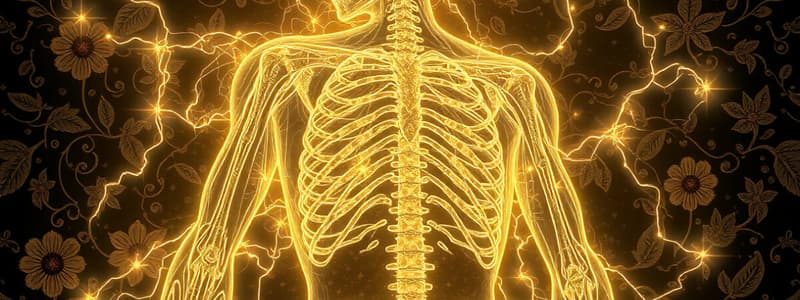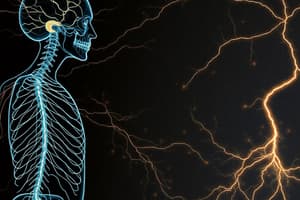Podcast
Questions and Answers
What is the significance of the centre of gravity in biomechanical calculations?
What is the significance of the centre of gravity in biomechanical calculations?
- It identifies the point where forces are balanced for stability. (correct)
- It measures the speed of muscular contractions.
- It dictates the angle of muscle force application.
- It determines the maximum length of a lever arm.
In which type of lever system is the load positioned between the fulcrum and the effort?
In which type of lever system is the load positioned between the fulcrum and the effort?
- Class III lever
- Class IV lever
- Class II lever (correct)
- Class I lever
What is required for a body to achieve static equilibrium?
What is required for a body to achieve static equilibrium?
- The weight must be concentrated at the extremities of the lever.
- The total moment around any point must equal the weight of the object.
- The total upward and downward forces must equal zero. (correct)
- The lever arm must be at a right angle to the force applied.
Which factors primarily determine the maximum tension achievable by human muscle?
Which factors primarily determine the maximum tension achievable by human muscle?
How is the centre of gravity typically determined for uniformly dense symmetrical objects?
How is the centre of gravity typically determined for uniformly dense symmetrical objects?
What aspect of muscle contraction is referred to by the rate of force development?
What aspect of muscle contraction is referred to by the rate of force development?
Which muscle architecture is more suited for producing maximum force?
Which muscle architecture is more suited for producing maximum force?
What is the primary functional consequence of a sprinter’s muscle contraction compared to that of a long-distance runner?
What is the primary functional consequence of a sprinter’s muscle contraction compared to that of a long-distance runner?
What characteristic of pennate muscles contributes to their higher force generation?
What characteristic of pennate muscles contributes to their higher force generation?
Which statement best describes the relationship between muscle architecture and its purpose?
Which statement best describes the relationship between muscle architecture and its purpose?
Flashcards
Rate of Force Development
Rate of Force Development
How quickly a muscle can generate force during the initial phase of contraction.
Muscle Architecture
Muscle Architecture
The arrangement of muscle fibers within a muscle, affecting its ability to generate force and control movement.
Centre of Gravity (CofG)
Centre of Gravity (CofG)
The point in a body where its mass or weight is evenly distributed and the force of gravity acts.
Parallel Muscle
Parallel Muscle
Signup and view all the flashcards
Pennate Muscle
Pennate Muscle
Signup and view all the flashcards
CofG Significance
CofG Significance
Signup and view all the flashcards
Sarcomere
Sarcomere
Signup and view all the flashcards
Centre of Gravity Location
Centre of Gravity Location
Signup and view all the flashcards
Lever
Lever
Signup and view all the flashcards
Static Equilibrium
Static Equilibrium
Signup and view all the flashcards
Study Notes
Musculoskeletal System, Nervous System & Bioelectricity
- This presentation covers the musculoskeletal system, nervous system, and bioelectricity, focusing on the skeletal lever system.
Learning Outcomes
- Students will be able to define and understand the significance of center of gravity.
- Students will be able to draw and explain the rate of force development in human muscles.
- Students will be able to define moment, torque, and lever.
- Students will be able to recognize conditions for static equilibrium in anatomical examples.
- Students will be able to calculate biomechanical forces using the principle of moments.
- Students will be able to define and calculate mechanical advantage.
- Students will be able to differentiate between Class I, II, and III levers with anatomical examples.
- Students will be able to discuss risks of back injury related to poor lifting techniques.
Centre of Gravity
- The center of gravity (CofG) is the point around which a body's mass or weight is evenly distributed.
- Gravity acts through this point.
- The center of gravity is the single point that moves according to Newton's laws of motion.
- For uniformly dense and symmetric objects, the center of gravity is located at the geometric center.
- When investigating levers, the CofG location is important.
- The center of gravity for symmetrical/homogeneous body parts are typically at their midpoint.
Centre of Gravity and Stability
- An object is stable when its center of gravity lies above its base of support.
- Increasing the base support area increases stability.
- Lowering the center of gravity increases stability.
Force Development
- Rate of force development (RFD) measures explosive strength.
- RFD can be generated in the early phase of muscle contraction (0–200 ms).
- RFD affects functional performance (e.g., sprinters vs. long-distance runners).
- Muscle architecture affects force development.
- Parallel muscles have sarcomeres in series, fibers parallel to tendons, and greater range of motion than pennate muscles.
- Pennate muscles have sarcomeres in parallel, and fibers angled to the tendon, so they produce more force but have a shorter range of motion.
- Maximum muscle tension is correlated to physiological cross-sectional area (PCSA), and is highest at normal resting length.
Levers
- Levers are simple machines that transmit force.
- A lever consists of a rigid beam pivoted at a fulcrum.
- The turning effect of a force is called a moment.
- Torque is the rotational force causing an object to rotate around an axis.
- Moment of force equals force times perpendicular distance from pivot.
Class I Lever
- The fulcrum is between the load and effort.
- Examples: neck muscles, head balance, etc.
- Class I levers can be either efficient or inefficient depending on fulcrum location.
Class II Lever
- The load is between the fulcrum and effort.
- Always efficient, designed for strength.
- Examples: calf muscles, weight-lifting activities.
Class III Lever
- The effort is between the load and fulcrum.
- Always inefficient, designed for speed and range of motion.
- Common in the human body, examples: biceps curl, elbow flexion.
Back Injury
- Normal load on the back depends on activity.
- Lifting heavy objects, or poor lifting technique can significantly increase loading on the back muscles.
- Back injuries may occur due to excessive forces on these muscles.
- Techniques for keeping the back safe during lifting include: bending the knees, maintaining a straight back, keeping the load close to the body, and using leg and core muscles.
Studying That Suits You
Use AI to generate personalized quizzes and flashcards to suit your learning preferences.
Related Documents
Description
This quiz explores the musculoskeletal and nervous systems, emphasizing their functions in biomechanics and the principles of bioelectricity. Students will learn about key concepts such as center of gravity, levers, and static equilibrium, while also understanding the importance of proper lifting techniques to prevent injuries.




